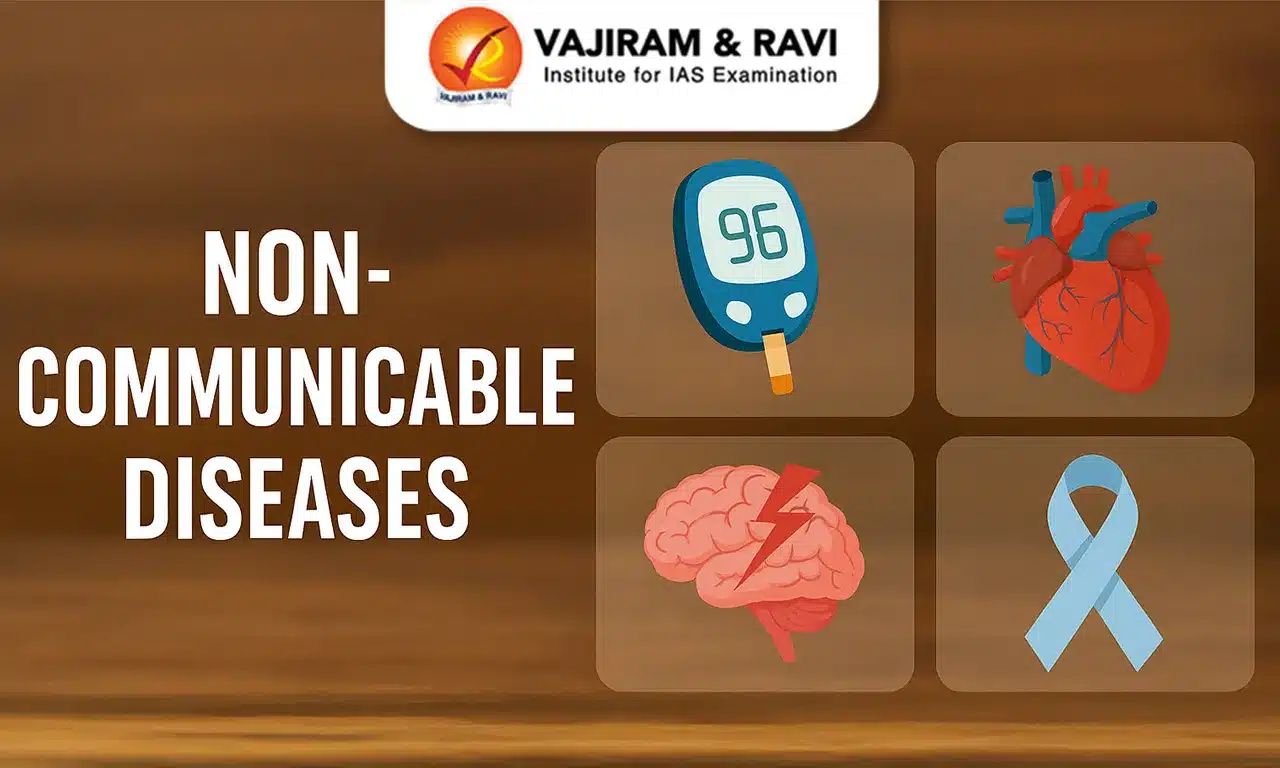Non-communicable diseases (NCDs), also known as chronic diseases, are not contagious. These illnesses develop slowly and do not show symptoms in their early stages. They require treatment for several years, and some require treatment for the rest of their lives.
The main types of non-communicable diseases are diabetes, coronary heart disease, stroke, cancer, and chronic respiratory diseases (such as chronic obstructive pulmonary disease and asthma).
About Non-Communicable Diseases (NCDs)
Non-communicable diseases (NCDs) are caused by a confluence of genetic, physiological, environmental, and behavioural factors. Currently, non-communicable diseases are a major cause of premature death globally.
- NCDs like cardiovascular diseases, cancer, diabetes, and chronic respiratory diseases are the leading causes of mortality in the world.
- These four groups of diseases account for over 80% of all premature deaths from NCDs.
- It kills 41 million people every year, corresponding to a total of 71% of all deaths worldwide.
- Low- and middle-income countries bear the brunt, with 86% of the 17 million premature NCD deaths occurring before the age of 70.
- Early detection, screening, treatment, and palliative care are vital components in addressing Non-communicable diseases.
Risk Factors for Non-Communicable Diseases
A risk factor is a condition or behaviour that raises the possibility of developing a specific disease, injury, or other health condition. The risk factors can lead to Non-communicable diseases. The more risk factors one has, the greater the chance of getting a particular disease.

Types of Non-Communicable Diseases
The non–communicable diseases may occur due to genetic and lifestyle factors. When these are caused by an unhealthy lifestyle, these diseases are also called lifestyle diseases.
- An arbitrary classification of non–communicable diseases can be:
- Lifestyle diseases, such as diabetes, hypertension, heart disease, stroke and cancer.
- Mental health diseases like depression and trauma.
- The four main types of NCDs are cardiovascular disease, cancer, chronic respiratory disease, and diabetes.
- According to the World Health Organisation (WHO) cardiovascular diseases account for the majority of NCD deaths, or 17.9 million people per year, followed by cancers (9.3 million), chronic respiratory diseases (4.1 million), and diabetes (2.0 million including diabetes-related kidney disease deaths).
Hypertension
Hypertension (high blood pressure) occurs when the heart has to work harder than usual to pump blood to all body parts. This puts more strain on the heart. When the pressure in blood vessels is too high (140/90 mmHg or higher), it is considered hypertension.
- Hypertension is also known as a "silent killer" because it might exist without causing any warning signs or symptoms.

- Risk factors: Advancing age, family history, obesity, unhealthy diet, lack of physical activity, consumption of tobacco, excessive alcohol and stress, etc.
- Symptoms: Very high blood pressure can cause headaches, blurred vision, chest pain, dizziness, difficulty breathing, nausea, abnormal heart rhythm etc.
- Complications: If left uncontrolled, hypertension could cause stroke, myocardial infarction, cardiac failure, renal failure, and blindness.
- Prevalence in India: It is estimated that at least one in four adults in India has hypertension, but, only about 12% of them have their blood pressure under control.
Diabetes Mellitus
Diabetes is a chronic disease that occurs when the pancreas fails to produce enough insulin or when the body is unable to use the insulin that is produced. Normally, a blood glucose level taken randomly of over 140 mg/dl should lead to a suspicion of diabetes.
- Types: There are two types of diabetes
- Type 1 Diabetes (T1DM): The body does not produce insulin at all and requires daily administration of insulin. This may be due to genetics, changes in environmental risk factors, and/or viral infections. Neither its cause nor the means to prevent it are known.

- Type 2 Diabetes (T2DM): This is the most common type of diabetes. The body produces some insulin, but not enough or the cells cannot use this insulin very well.

- Risk factors: Unhealthy diets, physical inactivity.
- Symptoms: Frequent urination, increased hunger, excessive thirst, unexplained weight loss, lack of energy, extreme tiredness, slow healing of wounds, dry or itchy skin.
- Prevention: Type 2 diabetes is often preventable by lifestyle changes like maintaining a healthy body weight, and avoiding sugar and saturated fat.
- Complications: It’s a major cause of blindness, kidney failure, heart attacks, and strokes.
Cardiovascular Diseases
Cardiovascular Diseases (CVDs) is a general term for conditions affecting the heart or blood vessels. It is associated with damage to arteries in organs such as the brain, heart, kidneys, and eyes. The most common cardiovascular disease includes coronary heart disease like heart attack.
- Heart Attack: A heart attack (myocardial infarction) occurs when the heart’s supply of blood is stopped due to the deposition of fat, thus blockage in the blood vessels of the heart. It is defined as severe chest pain for more than 30 minutes, radiating to the left arm, shoulder, or jaw and not relieved by painkillers.

- Symptoms: Chest pain or discomfort, weakness, light-headed, or faint, discomfort in the jaw, neck, or back and one or both arms or shoulders, shortness of breath.
- Complications: Arrhythmias (heart may develop an abnormal heartbeat following a heart attack due to your damaged heart muscle disrupting electrical signals), heart failure, cardiogenic shock (heart suddenly can’t pump enough blood to your body), heart rupture.
- Stroke: A stroke (brain attack), occurs when the blood supply to a part of the brain is cut off or when a blood vessel in the brain bursts. If this happens, the brain is deprived of oxygen, and parts of the brain may be permanently damaged.

- Types:
- Ischemic stroke happens when blood clots or other particles clog blood vessels in the brain.
- Hemorrhagic stroke occurs when an artery in the brain leaks or ruptures (breaks open). The leaked blood increases the pressure on brain cells, causing them to be damaged.
- Medical risk factors include high blood pressure, high cholesterol, diabetes, and a personal or family history of stroke or heart attack.
- Stroke is the world's second-leading cause of death and the third-leading cause of disability. One out of every four people is at risk of having a stroke during their lifetime.
Chronic respiratory diseases (CRDs)
Chronic respiratory diseases (CRDs) impact the airways and other lung structures. Among them most common are chronic obstructive pulmonary disease, asthma, occupational lung diseases, and pulmonary hypertension.
- CRDs are not curable; however, different kinds of treatment that help open air passages and alleviate shortness of breath can help control symptoms and improve daily life for people living with these conditions.
- Risk factor: In addition to tobacco smoke, other risk factors include air pollution, occupational chemicals and dust, and frequent lower respiratory infections during childhood.
Cancer
Cancer is a disease that occurs when cells divide uncontrollably in any part of the human body, contrary to the usual regulation by the immune system. This uncontrolled division leads to the formation of lumps or growths, commonly referred to as tumours.
- Types of tumours: There are two types of tumours benign (non-cancerous) and malignant (cancerous).
- Benign tumours are normally confined to their original site, do not spread to other parts of the body, and cause little damage.
- Malignant tumours are composed of a mass of proliferating cells known as neoplastic or tumour cells.
- The three most commonly occurring cancers in India- cervix and breast cancers among women and oral cancers among women & men.
- Cervical cancer originates in cervix cells, the lower part of the uterus connecting to the vagina. It typically progresses slowly.
- Around 75,000 women in India die each year of cervical cancer.
- The HPV vaccine is an effective preventive tool in the fight against cervical cancer.
- To decrease incidences of cervical cancer, India plans to implement an immunisation campaign targeting Human Papillomavirus (HPV).
- Causes: Transformation of normal cells into cancerous neoplastic cells may be induced by physical, chemical, or biological agents. These agents are called carcinogens. These changes are the result of a person's genetic factors interacting with three types of external agents:
- Physical carcinogens (ultraviolet and ionising radiation)
- Chemical carcinogens (asbestos, components of tobacco smoke, and alcohol)
- Biological carcinogens, (infections from certain viruses, bacteria, or parasites.
- Cancer-causing viruses are called oncogenic viruses.
- Risk factors: Tobacco use, alcohol consumption, unhealthy diet, and air pollution.
- Prevention: Maintaining healthy body weight, avoiding consumption of alcohol, avoiding ultraviolet radiation exposure, etc.
- According to the Indian Council of Medical Research-National Cancer Registry Programme (ICMR-NCRP), the new cancer cases in India will rise from nearly one million new cases in 2012 to over 1.5 million by 2035.
India and Non-Communicable Diseases
Noncommunicable diseases (NCDs) account for 66% of all deaths in India, with 22% being premature deaths in 2019. The SDG target of reducing premature deaths from the four major NCDs by one-third from 2015 to 2030 will almost certainly be missed by India, with researchers projecting a 15.6 per cent decline from 2015 to 2030.
The Government of India is implementing several programmes to reduce the burden of non-communicable diseases.
- National Programme for Prevention & Control of Non-Communicable Diseases (NP-NCD) (earlier known as NPCDCS).
- Implemented through the National Health Mission and launched in 2010 with a focus on strengthening infrastructure, human resource development, health promotion, early diagnosis, management, and referral.
- Indian Hypertension Control Initiative (IHCI):India has set a target of a 25% relative reduction in hypertension prevalence by 2025.
- To accomplish this, India has launched the IHCI to accelerate access to treatment services for over 220 million hypertensive people in India.
- National Tobacco Control Programme (NTCP): Launched in 2007-08, it aims at discouraging the use of tobacco with special emphasis on the protection of children and young people.
Last updated on November, 2025
→ Check out the latest UPSC Syllabus 2026 here.
→ Join Vajiram & Ravi’s Interview Guidance Programme for expert help to crack your final UPSC stage.
→ UPSC Mains Result 2025 is now out.
→ UPSC Notification 2026 is scheduled to be released on January 14, 2026.
→ UPSC Calendar 2026 is released on 15th May, 2025.
→ The UPSC Vacancy 2025 were released 1129, out of which 979 were for UPSC CSE and remaining 150 are for UPSC IFoS.
→ UPSC Prelims 2026 will be conducted on 24th May, 2026 & UPSC Mains 2026 will be conducted on 21st August 2026.
→ The UPSC Selection Process is of 3 stages-Prelims, Mains and Interview.
→ UPSC Result 2024 is released with latest UPSC Marksheet 2024. Check Now!
→ UPSC Prelims Result 2025 is out now for the CSE held on 25 May 2025.
→ UPSC Toppers List 2024 is released now. Shakti Dubey is UPSC AIR 1 2024 Topper.
→ UPSC Prelims Question Paper 2025 and Unofficial Prelims Answer Key 2025 are available now.
→ UPSC Mains Question Paper 2025 is out for Essay, GS 1, 2, 3 & GS 4.
→ UPSC Mains Indian Language Question Paper 2025 is now out.
→ UPSC Mains Optional Question Paper 2025 is now out.
→ Also check Best IAS Coaching in Delhi
Non-communicable Diseases FAQs
Q1. What are Non-communicable Diseases?+
Q2. What are the major non-communicable diseases?+
Q3. What are the main causes of non-communicable diseases?+



















